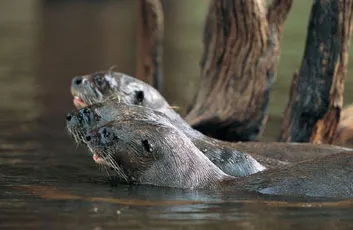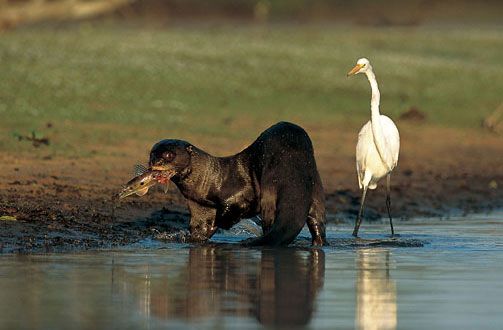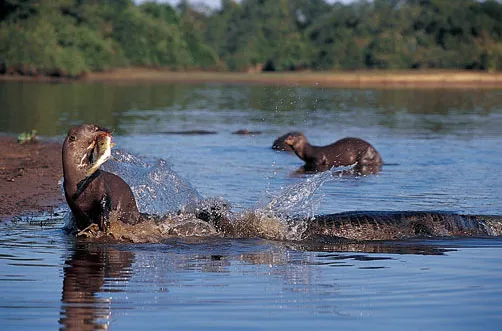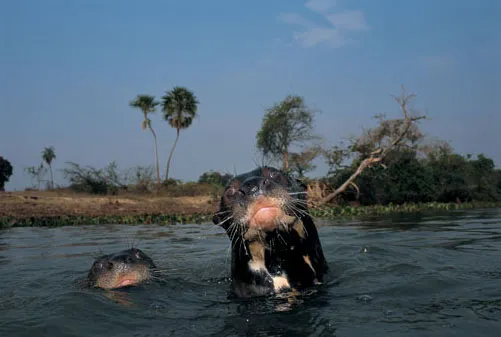Otterly Fascinating
Inquisitive, formidable and endangered, giant otters are luring tourists by the thousands to Brazil’s unspoiled, biodiverse waterscape
Bloodcurdling cries shatter the stillness of dusk in the Pantanal, in southern Brazil, as if a pack of wolves were gathering for a hunt. The urgent yelping silences all other wildlife: the squawking of hyacinth macaws, the grunting of caimans, the growl of an ever-elusive jaguar. Even my guide, Senhor Japão, cuts the outboard of our aluminum-hulled skiff, and we drift silently on the barely perceptible current of the Rio Negro.
Under the dome of fading sky, the river cuts a twisting avenue through the forest. And then we come upon what we have journeyed here to see: a mob of agile, seal-like animals, twisting and dodging through the water, leapfrogging one another, overtaking our boat easily and casting curious but hurried glances at us.
“Lobos de agua?” I whisper to Senhor Japão in Spanish, his and my second language. “Water wolves?”
“Sí, ariranhas,” he says, using their Portuguese name.
The giant river otters pass around the next bend in the river, and their caterwauling reaches a crescendo. There are violent splashes, followed by the sound of large bodies crashing through the undergrowth. Then, the droning of insects and the chatter of birds resume. With a casual slap, Senhor Japão dispatches the first mosquito of the evening. The ariranhas have crossed to an oxbow lake, he says; perhaps they have a den there. We, too, must return home to the ranch, or fazenda, also called the Rio Negro. He fires up the outboard and makes a swooping turn, racing the darkness.
This is my first day in the Pantanal, the world’s largest freshwater wetlands, which spreads across 54,000 square miles of Brazil, Bolivia and Paraguay. In Brazil alone, the Pantanal covers an area the size of Kansas—an Evergladeslike waterscape of oxbow lakes, woodlands and savannas— that harbors the highest concentration of tropical wildlife in all of South America.
The Fazenda Rio Negro is a cluster of terra-cotta-roofed structures built around a whitewashed 1920s mansion with spacious verandas and a tiny family chapel. The 19,400- acre fazenda is one of about 1,100 large cattle ranches spread across the Pantanal. Even with these livestock operations, this area of Brazil remained almost unknown until about a decade ago. Then, in 1994, the area became the setting for Pantanal, a Brazilian soap opera whose beautiful heroine had the curious habit of morphing into a female jaguar. Set against stunning vistas and a superabundance of wildlife, the program proved an instant hit, and the Pantanal was “discovered.” One by one, the fazendas became centers for a lucrative trade in ecotourism. In 2000, the onetime backwater welcomed a million such visitors, who came to view its rich biodiversity on Serengeti-style safaris. International environmental organizations also began to take note of the Pantanal. In May 1999, Conservation International (CI), a nonprofit Washington-based environmental group, bought the Fazenda Rio Negro and, with the help of Brazilian agencies, turned it into a reserve and research center for ecologists.
Here I meet 27-year-old Helen Waldemarin, an enthusiastic graduate student in ecology at Rio de JaneiroStateUniversity who is surveying the otter population for CI and is dressed in python-skin fatigues. She has invited me along on one of her excursions. “Ecotourism can be a doubleedged sword,” she tells me the day before we are to set out. “It can help conservation or disrupt it.”
With a footprint that is often bigger than a human hand, the giant river otter is the largest of the world’s 13 otter species, reaching six feet in length and weighing up to 70 pounds. A giant otter reclining on a riverside log, its powerful hind legs giving its body the shape of a sidelong question mark, is as regal, and as prepossessing, as any cheetah or tiger. After the jaguar, the giant otter is South America’s largest and most capable predator. But unlike the jaguar—and all other otters as well—it lives and hunts in groups of up to nine individuals. In 1978, a group of giant otters attacked a Brasília policeman at the city’s zoo. The off-duty sergeant tried to rescue a child who had fallen into an enclosure containing an otter family and pups. (He died of infections caused by their bites. The child survived.) The widely publicized incident led to a popular belief in Brazil that giant otters can attack and capsize a canoe and tear its occupants to pieces, though no such thing has ever happened.
Last year, the highly mobile otters built a den right across the river from the fazenda’s buildings, but the animals have since moved. Waldemarin is not sure whether activity at the ranch caused them to leave. In any case, they often come back, patrolling their territory. “We begin looking for their dens bright and early in the morning,” she briefs me. To maximize observation time and reduce disturbance, we will travel to our locations before dawn and return well after sundown. I learn that the job of an otter researcher involves coping with a great deal of sleep deprivation.
By first light, Waldemarin and I, with Senhor Japão at the helm of our small boat, are already puttering over the Rio Negro’s olive green water, a highway that meanders through a mosaic of ponds and lakes, each teeming with fish of many species. Waldemarin explains that the otters maintain a network of dens, camps and resting places that they visit and clean regularly. Senhor Japão is expert at spotting the otters’ entrances, even though they are often disguised by overhanging vegetation. The entrance tunnel, often 15 feet long, leads to a grand chamber with a floor area the size of a suburban living room, large enough to accommodate an otter family. He nudges the boat into a steep, crumbling clay bank, striated with vertical claw marks where the otters had clearly climbed out of the water. Senhor Japão points to a dark opening the size of a squashed car tire just below the lip of the bank. The mud around the entrance is still wet; the otters must have just left.
Behind us comes a snort, and we all spin around in the canoe to see a streamlined head, whiskered like a bottlebrush, cutting an arrowhead wake. Snorting in what sounds like agitation, the otter stops to investigate us, craning its head, standing up in the water for a better view. Waldemarin looks for the cream-colored markings on its neck that are as individual as a human’s fingerprints, but before she can make an identification, the giant otter ducks, dives and disappears.
Waldemarin tells me that the usually inquisitive otters are acting uncharacteristically wary; soon we find out why. At the entrance to another den, Senhor Japão points out a log that, at closer examination, turns out to be a large caiman, a species of crocodile. “The otters must already have cubs,” Waldemarin says. The caiman has been lured by the promise of food.
Big caimans are not the otters’ only predator. Their velvety chocolate-brown fur is among the finest in the world, and the high price it once fetched on international markets led to decades of relentless and uncontrolled hunting by man. Throughout their original range, from the Orinoco basin in Colombia and Venezuela to the Pantanal and northern Argentina, the curious otters, often approaching canoes in entire families, were an easy target for hunters who sought their pelts.
Official statistics only hint at the true extent of the slaughter: during a seven-year period in the 1960s, Brazil exported more than 40,000 pelts. But these figures don’t account for a thriving illegal trade or the fact that more specimens were killed than recovered. Alarmed by the rapid disappearance of the giant otters, several South American countries granted them legal protection in the mid-1970s. By then, the Convention on International Trade in Endangered Species (CITES) had outlawed trade in otter skins, but clandestine commercial hunting continued, particularly in remote areas of the Amazon and Venezuela, with most pelts smuggled out via Colombia. As the numbers of giant otters in the wild plummeted, the price for their skins increased, and by the late ’70s, they were fetching $250 each. In 1979, Venezuela was the last country to ban the hunting of otters. Since then, the animals have returned in significant numbers— to about 5,000—though they remain on the endangered list of the World Conservation Union (WCU).
Giant otters live in locally dense populations scattered through pockets of remote habitat. Outside the Pantanal, their other stronghold is Manu Biosphere Reserve, a river basin the size of Massachusetts, in southeastern Peru. Here the Frankfurt Zoological Society has coordinated a number of systematic field studies over the past dozen years.
Martha Brecht Munn, a WCU biologist, observed a family of otters in Peru hunting an anaconda, among the world’s largest snakes. “Two or more otters would bite and hold the snake at different places on its body,” she wrote in Animal Kingdom magazine. “They would then thrash it against a fallen tree trunk and engage in what looked like a tug-ofwar with an animated fire hose.” In a group, they could also make short work of a five-foot-long caiman, devouring the reptile—skull, bones and all—in 45 minutes. Most of the time, however, giant otters prefer fish. Brecht Munn wrote that they seem to hunt together as much for camaraderie as to subdue large prey.
She also described some cubs’ first swimming lessons: “When [they] were about two weeks old, their [parents] carried them outside one by one . . . and dropped them into the water at the den entrance. The cubs were about the size of a loaf of bread, their eyes still closed, and they bobbed about helplessly.” All the adult otters circled the cubs to protect them from loitering caimans.
Another predawn start in the pantanal, and this time I’m searching for otters with Marion Kallerhoff, a South African wildlife specialist here to work with scientists studying jaguars, hyacinth macaws and giant otters. As we push off into the dark water, I scan the banks with my flashlight; the eyes of caimans light up like reflective highway markers. After an hour of paddling our canoes, we stop, a half mile across the river from the most likely otter dens, to await the daylight. The foghorn-like humming of curassow birds begins to echo from the forest, and jabiru storks cross against the gray sky like small aircraft. But first up are the mosquitoes. Because otters have an excellent sense of smell, Kallerhoff suggested we not use any insect repellent. Now I cringe against the onslaught. Then, all of sudden, I forget the insects’ annoying whine.
Across the river, a whiskery face pops up with a nostrilclearing snort, then another face appears, followed by yet another. A family of giant otters has just emerged from its den and begins to feed with the splashy exuberance of kids in a backyard swimming pool. I ease my canoe back into the river, quietly paddle upstream, then drift down, still as a log.
The otters dive eagerly into the shallow water, churning twisting trajectories that trace their frantic underwater chases. I’d read that biologists in eastern Colombia have observed giant river otters swimming with Amazon River dolphins. Indeed, the otters’ water antics appear dolphinlike, until, that is, they surface, roll over on their backs, grab fish with their webbed paws and wolf them down.
Crunch! One otter snaps the backbone of a piranha with its powerful molars while another torpedoes past my canoe to emerge with a stubby two-foot-long pintado catfish flapping in its mouth. Then, as if on cue, all this hyperactive commotion stops, and the otters launch into some impromptu landscaping around the den. They huff and sniffle, rearranging the lianas, or vines, and tear at a floating raft of water hyacinth. Then the merry troupe is off again, snorting and splashing, playing what seems like an energetic game of tag as they head down the river and around the bend.
Kallerhoff catches up to scold me about getting too close. “In Manu Biosphere Reserve in Peru, the giant otters stopped breeding because boatloads of tourists were forever invading their space,” she says. These otters didn’t appear stressed, I protest, and they continued to feed. This appears to mollify Kallerhoff. But I can see that keeping tourists safe distances from these appealing creatures will be a monumental challenge.
Other threats to the giant otters’ well-being are more insidious. The Pantanal is like an immense sponge that soaks up water from surrounding uplands and thus acts as a giant settling pond for waterborne pollution. Biologists fear that levels of mercury, for instance, may be rising.
Much of Brazil and its neighbors are still in the grips of the search for El Dorado—gold. It is largely a quest of smallscale miners, but their collecting efforts add up. “Just within the Amazon basin, some 1.2 million people extract roughly 200 tons of gold a year,” says Frank Hajek, who comanages the Frankfurt Zoological Society’s giant otter project in Peru, “and the production of each gram of gold requires one to four grams of mercury.” Up to 40 percent of this mercury escapes into the environment. An estimated 128 tons a year leaches into the Amazon alone.
“Our research in Manu, Peru, and the nearby gold mining areas shows that mercury levels in fish are too high for human consumption,” Hajek says. “At the same time, analysis of the [Peruvian] giant otters’ scat [feces] shows no traces of methylmercury and, since the otters eat primarily fish, this means that mercury must be accumulating in their bodies in toxic concentrations.” Hajek hasn’t yet been able to sample otter tissue to prove his theory. But he fears that many otters will die from mercury poisoning unless something is done. The solution, he says, is relatively simple. Miners could heat their ore in a closed vessel, capturing most of the mercury. But miners dislike this process—it produces a discolored lump of gold that fetches lower prices. Hajek says that giant river otters are also feeling the squeeze from ever diminishing rain forests. Although the home range of a typical otter family is only about 270 acres, they need thousands of acres to thrive. Young otters leaving their family often travel long distances on the water in search of the right den habitat, which usually includes a shallow lake, an abundance of fish and high banks in which to tunnel.
One biologist has estimated the Pantanal’s giant otter population at a relatively healthy 500, but there have been no measurements of mercury levels in the otters here. On my way out of Rio Negro, I take in one last view of their home from the window of the Cessna. In the course of a half hour, I spot flocks of spoonbills, egrets and storks, hundreds of caimans and capybaras, a lone swamp deer and tapirs. But the future of this abundance is far from certain. Despite a World Wildlife Fund initiative that saw UNESCO declare more than 96,000 square miles of the area a Biosphere Reserve in November 2000, only about 3 percent of the Pantanal is actually protected. The rest is in the hands of ranchers torn between development and conservation.
Recently, Conservation International of Brazil proposed creating a network of biodiversity corridors—continuous and unfenced strips of wild habitat that allow animals to range freely—throughout the Pantanal and the surrounding cerrado uplands. These corridors, carved mostly through private properties, would either be left uncultivated or farmed in an environmentally and otter-friendly manner. It sounds like a good idea: the ranchers would gain tax breaks and tourism opportunities, and the animals would get the room they need.
“The giant otters are perhaps our most captivating animals,” biologist Reinaldo Lourival, who leads the CI Pantanal branch, told me. “They can be easily glimpsed by visitors and so have become an umbrella species for conservation in the Pantanal. If we can ensure an adequate habitat for giant otters, much of our amazing biodiversity will be taken care of as well.”



